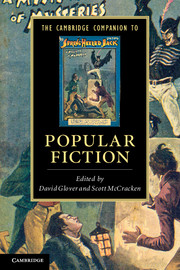Book contents
- Frontmatter
- Introduction
- 1 Publishing, history, genre
- 2 Fiction, theatre and early cinema
- 3 Television and serial fictions
- 4 The public sphere, popular culture and the true meaning of the zombie apocalypse
- 5 The reader of popular fiction
- 6 Reading time: popular fiction and the everyday
- 7 Gender and sexuality in popular fiction
- 8 Pulp sensations
- 9 Bestselling fiction: machinery, economy, excess
- 10 Comic books and graphic novels
- 11 Popular fiction in the digital age
- Further reading
- Index
- Cambridge Companions to …
1 - Publishing, history, genre
Published online by Cambridge University Press: 28 May 2012
- Frontmatter
- Introduction
- 1 Publishing, history, genre
- 2 Fiction, theatre and early cinema
- 3 Television and serial fictions
- 4 The public sphere, popular culture and the true meaning of the zombie apocalypse
- 5 The reader of popular fiction
- 6 Reading time: popular fiction and the everyday
- 7 Gender and sexuality in popular fiction
- 8 Pulp sensations
- 9 Bestselling fiction: machinery, economy, excess
- 10 Comic books and graphic novels
- 11 Popular fiction in the digital age
- Further reading
- Index
- Cambridge Companions to …
Summary
In one of its earliest (but still recognisably modern) incarnations, the trade of writing was linked to a specific locale: from the beginning of the seventeenth century, the name of Grub Street developed a very mixed reputation as the place in London where authors, and the booksellers and publishers who paid them, lived cheek by jowl, working together to turn a profit. But by the end of the eighteenth century, the street name had acquired an imaginative life of its own. No longer simply a commercial address, ‘Grub-Street’ became a dismissive term for any published work that had been hastily written for money and was thought to be of poor quality, the product of literary hacks, no matter where it had originated. This distinctly downmarket meaning endured. When George Gissing (1857–1903) began writing the novel he eventually called New Grub Street (1891), no street had borne that name for over fifty years; yet he could still credibly use the phrase to mark a point in the growth of the late Victorian publishing industry when the everyday reality of those who sought to make a living from writing, and particularly from writing fiction, seemed to be more debased and discouraging than ever before – or so Gissing would have his readers believe.
- Type
- Chapter
- Information
- The Cambridge Companion to Popular Fiction , pp. 15 - 32Publisher: Cambridge University PressPrint publication year: 2012
- 4
- Cited by

